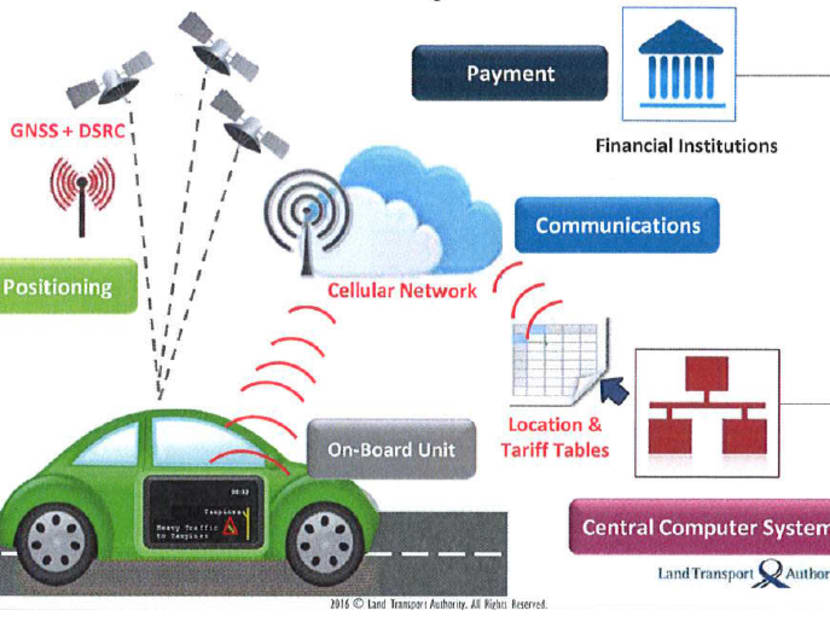Satellite-based ERP system to be rolled out from 2020
SINGAPORE — The Republic on Thursday (Feb 25) moved a step closer to developing a world-first second-generation Electronic Road Pricing (ERP) system using satellite technology, as the Land Transport Authority
SINGAPORE — The Republic on Thursday (Feb 25) moved a step closer to developing a world-first second-generation Electronic Road Pricing (ERP) system using satellite technology, as the Land Transport Authority (LTA) announced the award of a S$556 million tender to a consortium comprising NCS and MHI Engine System Asia (MHIES-A).
The new system, which will be rolled out progressively from 2020, paves the way for distance-based road pricing, but the authorities stressed Thursday that there are no plans yet to tweak the road pricing regime — although this will be reviewed “sometime down the road”, as LTA chief executive Chew Men Leong put it.
There will be an 18-month migration period during which both the current and new ERP systems will co-exist. LTA said that during the transition period, motorists can expect no change to the current charging regime. “Right now, the focus is to actually develop (and) operationalise the next-generation ERP system,” Mr Chew said. “We’ll make the decision in terms of how road-pricing should be going forward, after the system has gone live.”
Nevertheless, he highlighted the fact that the system “has the ability to provide the option... to look at how we can charge motorists based on the distance (they travel on) priced roads”. “And that opportunity exists because of the technology that is in place,” he said.
LTA deputy chief executive (infrastructure and development) Chua Chong Kheng added: “We also want to make sure the motorists get some time to get used to the system, understand the inferface and how it works. Otherwise you have too many changes immediately, it’s also not good for the motorist.”
After the transition period, ERP gantries will be phased out and temporary visual cues may be put up to help motorists adapt to the new system. Under the new system, the In-Vehicle Unit (IU) will be replaced by an On-Board Unit (OBU), preloaded with location and tariff tables.
The Government will bear the costs for a one-time replacement for Singapore-registered vehicles. Apart from displaying travel advisories and alerting motorists to charging points, the OBU – roughly the size of a smartphone - could also be used to pay for roadside parking, checkpoint tolls and the use of off-peak cars electronically. “Our coupon system will become a thing of the past,” said Mr Chew. Payment can be done via CEPAS cards, credit cards, virtual payment accounts or GIRO.
The new system will have island-wide coverage. In areas where the satellite coverage is weak, such as tunnels, beacons will be used to augment signal strength.
The winning bid was selected from an initial shortlist of three bidders via a two-envelope process where the bids were assessed on quality and price factors, among other things. A consortium of Watchdata Technologies and Beijing Watchdata System eventually failed to make the cut after its proposal fell short on the quality criteria.
The bid from the consortium of NCS and MHIES-A was selected over the one submitted by ST Electronics (Info-Comm Systems), which was priced at S$1.26 billion.
“When you look at the two proposals, you have to look at the one that has the highest value for money,” said Mr Chew. “NCS and MHIES-A have a slight edge in terms of the overall proposed prices.”
MHIES-A is a wholly owned subsidiary of Mitsubishi Heavy Industries, which developed and implemented the current ERP system, while NCS has been maintaining it.
In a press release, the winning consortium said the next generation ERP system - which makes use of advanced satellite technology for congestion management - would be the “first-of-its-kind to be implemented nation-wide in an urban environment”.
In 2008, the authorities had revealed that each three-lane ERP gantry cost S$1.5 million. LTA reiterated yesterday that the current ERP system, which was implemented in 1998, is nearing the end of its lifespan and will become increasingly expensive and difficult to maintain. Speaking in Parliament in 2014, then-Transport Minister Lui Tuck Yew said that the annual operating cost of the system had risen by 80 per cent over the last decade.
The idea of a “next-generation” ERP system was first mooted here by the authorities more than a decade ago. Over that period, the accuracy of the Global Positioning System has improved tremendously, making it viable for implementation. Industry players had previously told TODAY that Government tests in 2006 showed the margin of error in certain areas was up to 50m. Today, sub-metre accuracy is attainable. The maturing of technology also means that such systems are now less costly.
In 2014, the LTA shortlisted the three consortia for the tender to develop the satellite-based ERP system. The move came after an 18-month system evaluation test in Woodlands Avenue 12 that concluded in December 2012.







